Rennie Scaysbrook | November 5, 2017
Take a deep breath, this is a big one from Ducati.
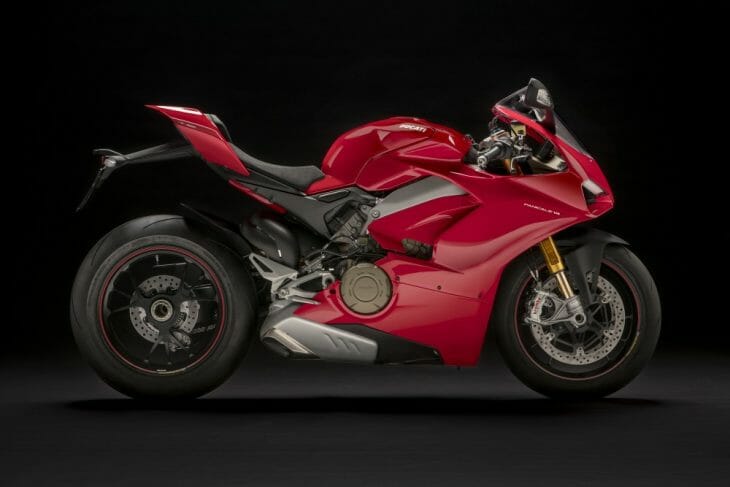 What a beast! A brand-new 214 hp V4 motor, a revised chassis, and electronics for days. The new V4 is sure to be a weapon. We can’t wait to ride it! (V4 S model shown)
What a beast! A brand-new 214 hp V4 motor, a revised chassis, and electronics for days. The new V4 is sure to be a weapon. We can’t wait to ride it! (V4 S model shown)
The Ducati derived from the loins of Andrea Dovizioso’s fire-breathing MotoGP monster has finally been revealed to the world’s motorcycling public at the annual EICMA Show in Milan, today.
The 2018 Ducati Panigale V4, V4 S, and V4 Speciale are the first mass-produced (not counting the limited edition Desmosedici RR D16 of 2006) four-cylinder machines from the Bologna concern, as it says farewell to the loved but ultimately unsuccessful—in WorldSBK titles, at least—1299 Panigale and 1199 Panigale R.
The V4 is carrying with it some hefty numbers with a claimed 214hp on tap, 88 lb-ft of torque and 429lb curb weight, which, when converted to kilograms, means Ducati has cracked the magic 1-1 hp to kg mark.
But it’s not just the motor that has everyone talking, with Ducati debuting a revised version of their monocoque frame that was first seen on the 1198 Panigale, as well as a host of electronic upgrades that will have you railing corner’s like Casey Stoner in no time (probably not like Casey Stoner).
This First Look is going to be a long one because there is a lot to get through. A lot.
The Panigale V4 Stradale motor: 214 furious Italian horses.
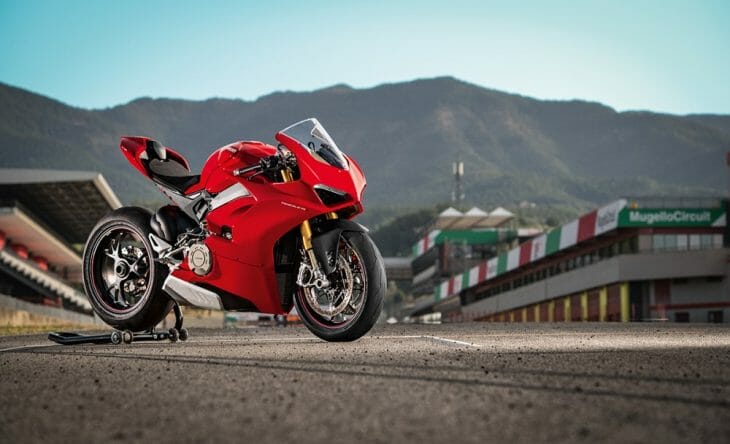 The perfect backdrop for the V4–the front straight of Mugello.
The perfect backdrop for the V4–the front straight of Mugello.
The new Panigale is powered by a 214 hp motor dubbed the Stradale—a V4 with an 81mm bore (the largest size allowed in MotoGP) and 53.5mm stroke, capable of a 14,000rpm redline, for a capacity of 1103cc, automatically putting it outside current Superbike racing rules (there’s a Panigale R coming later next year that will fix that). And if you grab yourself one of the Akrapovic titanium Ducati Corse exhaust systems with your V4, Ducati claims you’ll have a whopping 226 hp to play with. Yikes.
The V4’s cylinders are spaced at 90°, which Ducati claims evens up the first order forces and means they don’t have to use a power-sucking counterbalancer, and the motor itself is cantered rearwards at 42°—the same as in MotoGP (you’ll hear that a lot with the V4)—which allows for better weight distribution and larger radiators, as well as bringing the swingarm pivot as far forward as possible. The water pump is housed in the center of the V.
The motor’s casings are constructed using die-cast aluminum, with the 81mm housing pistons featuring “box in box” technology, which, according to Ducati “contains both skirt height and below-chamber thickness, helping to reduce attrition and inertial loads while maintaining the necessary strength and stiffness.”
The compression ratio is an impressive 14:1, with the pistons acting on forged steel conrods.
Ducati’s different crank
But one of the tricks of the V4 lies in the crankshaft. This is the first mass-produced Superbike to come with a counter-rotating crankshaft, again, like Dovi’s bike. Having a crankshaft that spins in the opposite direction to the wheels helps to reduce wheelies by producing inertia-linked torque in the opposite direction, which lowers the front of the bike and allows the rider to get on the gas harder. It also has the benefit of helping the rear stay planted under braking: As the revs drop, the motor produces inertial torque that works against the rear wheel lifting off the ground, so it’s a bit of a win-win for the rider.
There’s a bit of weight to come with the system because to have a contra-rotating crank you need the jackshaft to transfer the crankshaft drive through the gearbox to the rear wheel so it turns the correct direction.
Ducati is implementing the Twin Pulse firing order, which is not exactly a Big Bang firing order, but not far from it. The V4’s crank pin is offset at 70°, with the cylinders firing at 90° each (0°, 90°, 290°, 380°). Ducati claims firing the cylinders close together in that order makes the Panigale V4 sound like their MotoGP Desmosedici, as well as having the more advantageous fact of smooth throttle response and ass-burning acceleration.
Up top, the Ride-By-Wire Stradale gets Ducati’s first ever variable intake system, consisting of a fixed duct on the throttle body and a mobile duct that moves along steel guides by an electric motor. Four 52mm throttle bodies with twin injectors deliver the mixture to a revised Desmodromic valve system. The throttle bodies have sub butterflies in them, used for low load situations. When you’re on the gas hard, both butterflies are in use.
The Desmo system is essentially the same as what’s on the 1299 Panigale, it’s just everything has been lightened, shaved, miniaturized to fit inside smaller cylinder heads than the old V-twin. Eight 34mm intake and eight 27.5mm exhaust valves are operated by camshafts, who in turn are operated by two “silent” timing chains.
Getting the go to the ground is a six-speed gearbox mated to the Ducati Quick Shift system, which allows for up and down gearshifts without using the 11 plate wet, slipper action clutch. The clutch itself uses a progressive servo mechanism that compresses the friction plates when under drive without requiring any extra effort from the rider to release the clutch, giving a light lever pull.
Panigale V4: Chassis? What chassis?
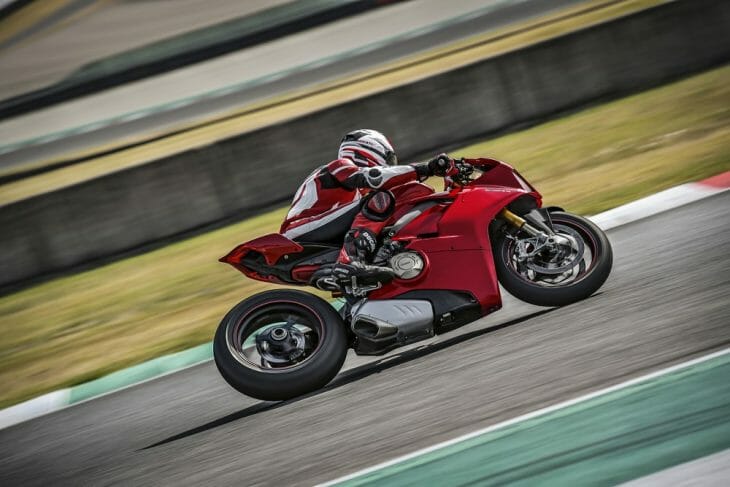 The new Panigale V4’s “Front Frame” allows the engineers to separate lateral and torsional rigidity.
The new Panigale V4’s “Front Frame” allows the engineers to separate lateral and torsional rigidity.
The new Panigale V4 gets what Ducati calls a new “Front Frame”, with the motor used as a stressed member of the chassis, like the 1299 V-twin.
The “Front Frame” differs from the traditional monocoque design because it allows torsional and lateral rigidity to be kept separate, which makes for a more responsive chassis when dealing with road surface roughness when cornering. Weighing 8.8 lb, the “Front Frame” bolts to the upper half-crankcase of the front cylinder head and to the V4’s rear cylinder head, with the engine acting as the fixing point for the rear suspension and swingarm attachment pivot.
Ducati claims one of the main advantages of the Front Frame is increased rigidity, as well as the reduced length of the pillars running alongside the engine means the bike is more compact in the seat/tank area.
At the rear, the V4 gets a magnesium sub- front frame and cast aluminum seat subframe, which is bolted to the “Front Frame” at the top and screwed into the top of the rear cylinder head at the bottom (think of a sideways “Y” with the two anchor points being the Front Frame and motor, and single leg being the seat).
For the suspension, the base model V4 will get fully adjustable 43mm Showa Big Piston Forks, a Sachs fully adjustable monoshock and Sachs steering damper. The V4 S and V4 Speciale will get Öhlins electronically-operated and adjusted NIX-30 forks, a Öhlins TTX36 shock and Öhlins steering damper, controlled by the second-generation control system Öhlins Smart EC 2.0 featuring, among other things, the new Objective Based Tuning Interface (OBTi—let the Star Wars jokes begin!).
Brakes are provided by Brembo (of course), but they’re the new Stylema four-piston Monobloc calipers, basically, the ones that supersede the widely used—and excellent, we must say—M50 calipers.
The Stylema’s weigh a claimed 70g less than the M50s per caliper and are more rigid for better feel at the lever, a shorter lever travel, and better response. These twin Stylemas bite down on twin 330mm discs up front with a single piston caliper clamping down on a 245mm disc out the back.
Pirelli has also come to the party with new tires to fit over the three-spoke cast aluminum wheels. The V4 is the first bike to come out with the new Pirelli Diablo Supercorsa SP 120/70 ZR17 at the front and the new size 200/60 ZR 17 at the rear, which is the size everyone rides on (but in a slick) in the Pirelli-only WorldSBK Championship.
Abbreviations for days
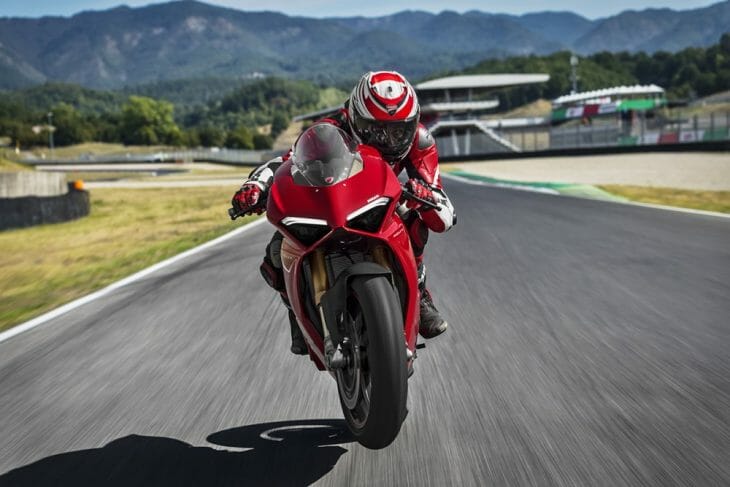 Clearly, the test rider doesn’t have the DWC engaged…
Clearly, the test rider doesn’t have the DWC engaged…
DTC EVO, DSC, DWC EVO, DPL, DQS EVO, EBC EVO, DES EVO… it’s enough to make your head spin. The V4 is now, in all likelihood, the king of the moto abbreviations, with almost every electronic aid/system updated to suit from the Panigale 1299.
The V4 is a case of almost infinite customization, as each of the parameters can be adjusted on their own, plus you will have preset levels of everything (including the electronic suspension for the S and Speciale models) stored in the factory-set riding modes.
The electronics are governed by the six-axis Bosch Inertial Measurement Unit, first employed on the 1299 back in 2015 that detects the bike’s roll, yaw and pitch angles. Starting with the ABS Cornering EVO system, you’ll get three levels to choose from, Levels One and Two for sport and track riding, and Three for general road riding. Level one has the ABS on the rear disconnected, to allow you to back it in like Chaz (if you’re game); Level two has both the front and rear connected, but still enables little drifts into corners with a higher ABS intervention. Level Three is full ABS intervention, front, and rear.
The Ducati Traction Control EVO (DTC EVO) system works by acting on the throttle bodies and ignition/injection advance to reign in a slide under acceleration. There are eight modes available, but the EVO’s main claim to fame is that it’s a learning system in that it senses when rear tire wear is happening and adjusts the intervention accordingly. Plus, in Levels One and Two, the EVO system now has a function called “spin on demand”, where the rider can get more spin than would normally be allowed to help the bike pivot around the steering head and finish the corner off.
The “spin on demand” feature is not to be confused with the Ducati Slide Control, which came out earlier this year on the Superleggera. The DSC works with the IMU and the traction control system by controlling the V4’s torque as a function of the slide angle. its goal is to improve out-of-the-corner performance by preventing slide angles that might otherwise be difficult to handle, and, like the DTC, DSC controls torque reduction by acting on the throttle body valves, spark advance decrease and injection cuts.
The Ducati Wheelie Control is a similar system to what the 1299 used, where it modulates power and torque delivery according to pitch information fed by the IMU to allow maximum acceleration without time-sapping wheelies.
When it’s time for a holeshot, you’ll be using the Ducati Power Launch system that has three separate levels—the first for high-performance race starts, down to level three which Ducati claims is “safer and more stable”, which we can only assume is for wet race starts (unless you plan on getting the holeshot on a road covered in diesel).
On the gearbox side, you get the Ducati Quick Shift as per previous Panigale’s that allows for clutchless up and downshifting, and you also get the Ducati Engine Brake Control (EBC) system that allows for three different levels for much or little engine braking on deceleration as required.
If you’re a lucky ducky and picked up a V4 S or Speciale, you’ll get the Ducati Electronic Suspension EVO, made by Öhlins, at your disposal. The electronic suspension is an evolution on what Panigale’s past and the Yamaha YZF-R1M have, operating under the new Öhlins Smart EC 2.0 system. You can have two flavors with the suspension—“Fixed”, which allows for the suspension to be adjusted manually, or “Dynamic”, where you leave the adjustment up to the Öhlins ECU while you ride.
“Fixed” will give you 32 virtual clicks for rebound and compression, done via the dash on the fork legs and 10 clicks on the shock.
But of course, you still have the Riding Modes to take into consideration. Here, you have three options: “Race”, “Sport”, and “Street”.
“Race” gives you the full 214 hp, a near 1-1 throttle response and on the S and Speciale, a hard (race) suspension set up. You also get a low intervention on the electronics (DTC, DWC, DSC, ABS), with the ABS Cornering feature active.
“Sport” will give you still the full 214 hp, a slightly less aggressive throttle response and softer suspension set-up (S and Speciale) with more intervention from the traction control, wheelie, etc.
“Street” gives you the 214 hp, but with a much softer throttle response, a soft suspension map (S and Speciale) and high intervention from the electronics.
All this is accessed via the new 5”, high-res TFT dash which has been totally worked over to make it easier to view and operate with all the usual things like speed, trips, fuel etc. However, now you can change the dash to have an old-school circular rev counter if you like, as well as access to the Ducati Multimedia System (pairing and using your phone via the dash). As the face of the electronics, anything and everything you want to change is done through the dash and the switchblocks on the bars.
Ducati has also fitted a Ducati Lap Timer GPS so you can keep track of up to 15 different laps in the bike’s ECU. When you come across the stripe at your local track/race day, hit the button to mark the spot on the GPS and you’re good to go—the lap timer logs your top speed, best lap, max rpm and last lap time—so telling little white lies about how quick you’ve just gone to your buddies is now a thing of the past.
The GPS lap timer works in conjunction with the Ducati Data Analyzer. The DDA records data channels including throttle opening, vehicle speed, engine rpm, gear selection, engine temperature, distance traveled, revs, DTC info and is an aftermarket feature for the base and S V4 but standard equipment on the Speciale.
Emperor’s new clothes
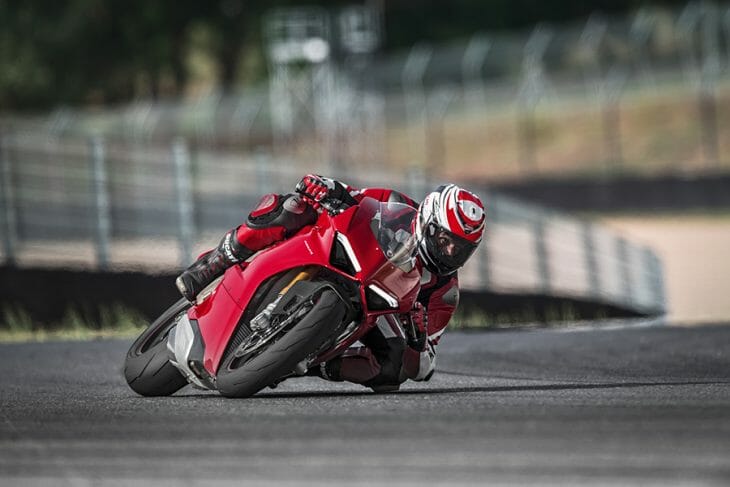 From this angle, it’s hard to tell the difference between this V4 and the old 1299 Panigale.
From this angle, it’s hard to tell the difference between this V4 and the old 1299 Panigale.
The shape of the V4 will be instantly recognizable as it’s mainly a continuation of the 1299 shape, just more muscular. Starting at the front, the LED headlights and Daytime Running Light have been overshadowed by the two intake ports to make the V4 look racier. The “Front Frame” is exposed, with the two pillars extending to the cylinder heads, and below the intakes are two wing attachments designed to increase the speed of the incoming airflow.
The magnesium front subframe has been left partially exposed to become part of the bodywork and also supports the mirrors and LED indicators.
The designers have incorporated a dual layer fairing, whereby the main fairing extends upward to the tank and the compartment that contains the battery (just behind the steering head). The tank itself is a split design, where half the fuel sits in the normal place in front of the rider but the other half is under the seat, again, like MotoGP. The tank is made from shell-cast aluminum half shells, which starts from the rear cylinder head, reach out to hug the tank part below the seat, ending up in the single-seater one-piece tail end, whose wing-shaped design is inspired by the shape of a car spoiler. The tail itself integrates full LED lighting, in the signature split lighting typical of past Panigale’s.
No MSRP has yet been confirmed by Ducati North America.
Ducati Panigale V4
- Ducati Red with grey frame and black wheels
- Main standard features
- New Desmosedici Stradale engine, 1,103 cm3
- New “Front Frame”
- 43 mm Showa Big Piston Forks (BPF), fully adjustable
- Sachs monoshock, fully adjustable
- Sachs steering damper
- Latest-generation electronic package with 6-axis Inertial Measurement Unit (6D IMU):
- ABS Cornering Bosch EVO; Ducati Traction Control EVO (DTC EVO); Ducati Slide Control (DSC); Ducati Wheelie Control EVO (DWC EVO); Ducati Power Launch (DPL); Ducati Quick Shift up/down EVO (DQS EVO); Engine Brake Control EVO (EBC EVO)
- Buttons for quick level shifting
- Riding Modes (Race, Sport, Street)
- 16-liter aluminum tank
- 5″full-TFT dashboard
- Full-LED headlight with DRL
- Two-seater configuration kit ®
- Braking system with new Brembo Stylema
- New Pirelli Diablo Supercorsa SP tires, 200/60 at the rear
- Pre-setting for Ducati Data Analyzer + GPS (DDA + GPS) and Ducati Multimedia System
- (DMS)
Ducati Panigale V4 S
- Ducati Red with grey frame and black wheels
- Same standard features as the Panigale V4 with the exception of: o Suspension and steering damper with Öhlins Smart EC 2.0 system
- Öhlins NIX30 forks
- Öhlins TTX36 shock absorber
- Öhlins steering damper
- Aluminum forged wheels
- Lithium-ion battery
- Cast Magnesium alloy front subframe
Ducati Panigale V4 Speciale
- “Speciale” color scheme with grey frame and black wheels
- Same standard features as the Panigale V4 S with the exception of:
- Carbon fiber front/rear mudguards
- Machined-from-solid top yoke with identification number
- Alcantara® seat
- Dedicated handle grips
- Adjustable foot pegs
- Carbon fiber heel guard
- Carbon fiber cover swingarm
- Racing articulated levers
- Racing fuel tank cap
- Brake level protection
- Full racing titanium Ducati Performance by Akrapovič exhaust system
- Racing screen
- Plate holder removal kit
- Machined-from solid mirror replacement plugs
- Ducati Data Analyzer + GPS(DDA+GPS)
- Bike cover